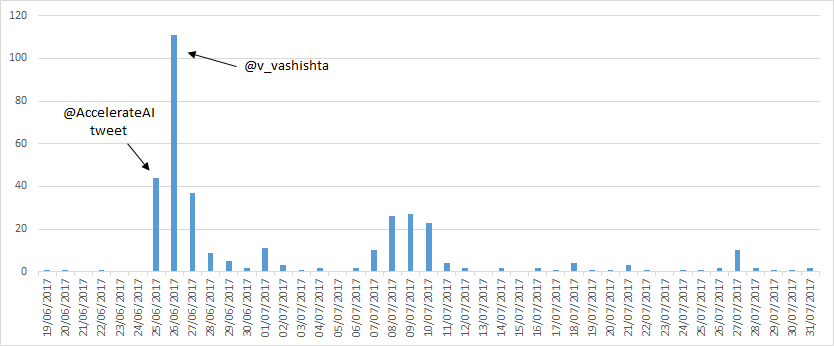This is second of three posts looking at the benefits and functions of the institutional repository through the lens of the top monthly downloads. This post looks at the different ways people get to the Open Access papers in ORO.
In June and July the top 50 downloads in ORO had another new entry:
In which the authors “introduce Dual-CNN, a semantically-enhanced deep learning model to target the problem of event detection in crisis situations from social media data.”
The paper was added to ORO on the 14th June and was 13th on the top downloads list in June with 211 downloads, and 24th with 146 downloads in July.
Referrals from social media seems to have had significant impact on the downloads this paper received, most notably from Twitter. On June 25th the Accel.AI (Artificial Intelligence network) twitter account tweeted a direct link to the paper:
On Semantics and #DeepLearning for Event Detection in Crisis Situations #AI #Researchhttps://t.co/pt4xV0uxyK
— accelai (@AccelerateAI) June 25, 2017
This was retweeted by Massimiliano Versace
RT AccelerateAI: On Semantics and #DeepLearning for Event Detection in Crisis Situations #AI #Researchhttps://t.co/6Vd8OTjDSz
— Massimiliano Versace (@maxversace) June 25, 2017
and then he retweeted himself retweeting @AccelerateAI
RT maxversace: RT AccelerateAI: On Semantics and #DeepLearning for Event Detection in Crisis Situations #AI #Resea… https://t.co/6Vd8OTjDSz
— Massimiliano Versace (@maxversace) June 25, 2017
The following day it was tweeted by Vineet Vashishta (a “Top 10 influencer on #MachineLearning & #DataScience) – this amassed the most retweets and likes.
On Semantics and #DeepLearning for Event Detection in Crisis Situations https://t.co/XsRS3WDMJy #MachineLearning
— Vin Vashishta (@v_vashishta) June 26, 2017
The tweets (and their retweets) seem to have had a direct impact on the downloads of the paper, especially the latter, which appears to have resulted in over 100 downloads of the paper.
This seems to tie in with a previous analysis of ORO downloads and the beneficial impact of the patronage of a Twitter Heavyweight. The lead author Grégoire Burel, Research Associate in KMi in STEM added:
“It seems to be a ‘completely out of the blue’ case. We have a follow up paper (‘Semantic Wide and Deep Learning for Detecting Crisis-Information Categories on Social Media’) that will be presented soon at ISWC17 (21-25 October) so it would be interesting to see if it gets picked up again after we publish it to ORO”
I’ll certainly be keeping an eye on it!
Search and Referrals
Whilst the majority of traffic coming to ORO is from a direct search in Google there is an increasing trend for referrals in ORO, both from social media and other referring websites like Google Scholar. In 2014 15% of traffic came from referrals, this year (to date) it’s up to 25%.
This shift in traffic from direct search to referrals is interesting. A Forbes article back in May, The Trend To Facebook Referrals Is A Risk To Google Search, called it context search:
“People often want answers to their questions within the context of their community. So “searches” are changing. People are going back to what they did before Google existed – they are asking for information from their friends. But online. And primarily using Facebook.”
I find that quite compelling and so far this year:
- Referrals from social media have a lower bounce rate (71%) than search (78%)
- Referrals from social media have a higher average session duration (1:45 minutes) than search (1 minute).
- Referrals from social media have more pages per session (2.13) than search (1.61).
However, results from general referrals (e.g. from clicking a link on a website) compare as well or better than referrals from social media:
- 66% bounce rate
- 1:45 minutes a session
- 2.16 pages per session
So maybe it’s not so much about someone you (kind of) know on social media giving you a tip, as actually knowing you’ve found what you were looking for.
Top downloads list for July:


